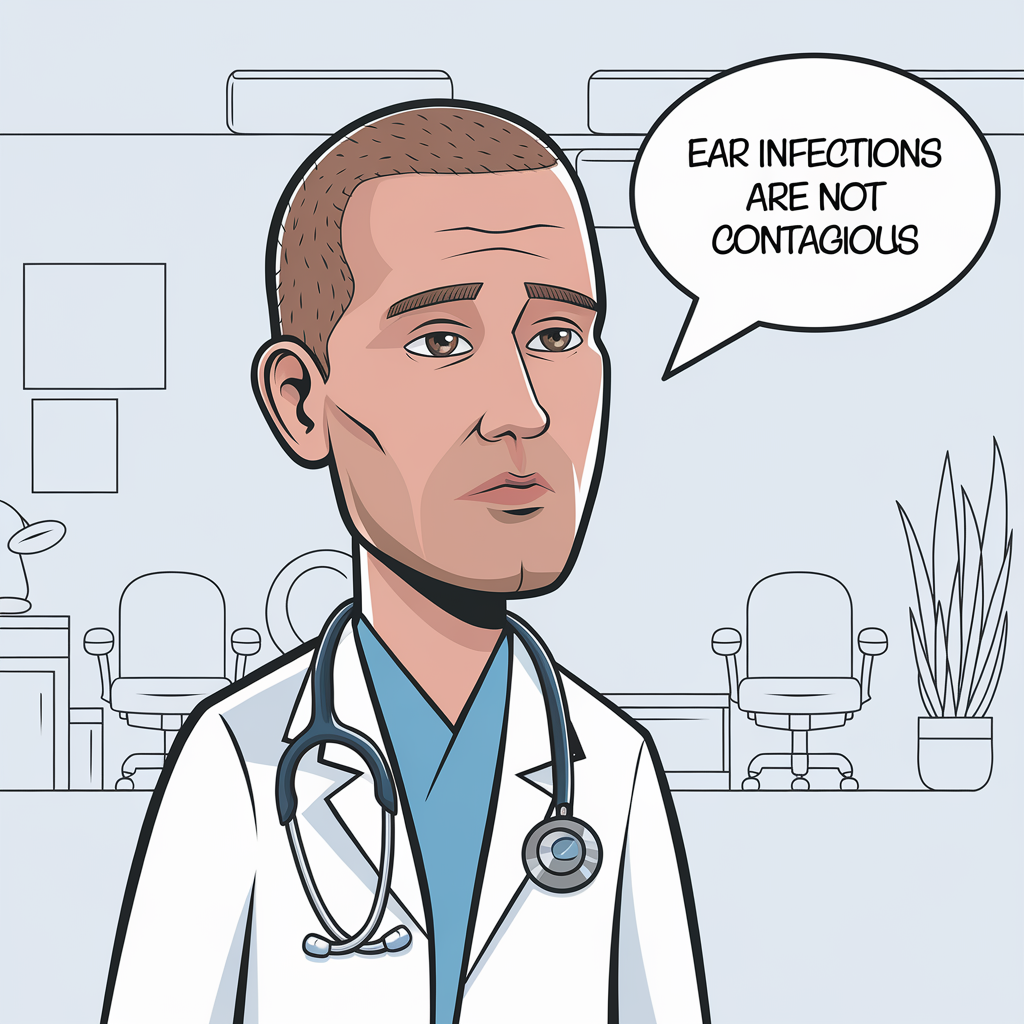Health & Fitness
Are Ear Infections Contagious? Must-Know Facts!

Ear infections can be a real pain—literally and figuratively. If you’ve ever experienced that throbbing pressure in your ear or watched someone struggle with discomfort, you know just how bothersome they can be. But beyond the pain, there’s often confusion surrounding these pesky infections. One of the most common questions is whether ear infections are contagious. This query sparks concern for parents, caregivers, and anyone who has dealt with recurrent episodes themselves.
In this blog post, we will dive into the essentials of ear infections: what causes them, their contagiousness—or lack thereof—and effective ways to prevent and treat them. Let’s unravel these must-know facts together!
Understanding Ear Infections
Ear infections occur when bacteria or viruses invade the middle ear, leading to inflammation and fluid buildup. They are most common in children but can affect individuals of all ages.
The middle ear is an air-filled space behind the eardrum. When it becomes infected, symptoms like pain, fever, and irritability often arise. This discomfort can range from mild to severe.
Different types of ear infections exist—acute otitis media is one of them. It usually develops suddenly and can be quite painful. On the other hand, otitis media with effusion involves fluid accumulation without infection signs.
Understanding how these infections develop helps in prevention and treatment strategies. Identifying symptoms early is crucial for effective management and relief from discomfort associated with ear issues.
Causes of Ear Infections
Are Ear Infections Contagious? Ear infections arise from various factors, primarily involving bacteria and viruses. These pathogens can enter the middle ear when the Eustachian tubes become blocked or swollen.
Allergies are a common culprit. They cause inflammation that disrupts the normal drainage of fluid in the ears. This buildup creates an ideal environment for germs to thrive.
Colds and sinus infections also play a role. When you’re battling respiratory issues, mucus can accumulate and lead to an infection in the ear.
Young children are especially vulnerable due to their anatomy. Their Eustachian tubes are shorter and more horizontal, making it easier for bacteria to reach the middle ear.
Environmental factors contribute as well. Exposure to secondhand smoke or pollution can irritate nasal passages, increasing infection risk significantly. Understanding these causes is vital in managing prevention strategies effectively.
Contagiousness of Ear Infections
Ear infections are often a source of concern, especially when it comes to their spread. The good news is that ear infections themselves aren’t contagious. You can’t catch an ear infection from someone else like you would the flu or a cold.
They typically arise from bacteria or viruses that cause upper respiratory issues. When these pathogens infect the middle ear, an infection may develop. So while you might be exposed to germs through close contact with someone who has a respiratory illness, this doesn’t mean you’ll end up with an ear infection.
However, children are particularly prone due to their developing immune systems and anatomy. If your child has been diagnosed with one, it’s essential to monitor for any signs in other family members but remember—it’s not about contagion; it’s more about shared environments and illnesses leading up to the infection.
How to Prevent the Spread of Ear Infections
To prevent the spread of ear infections, practicing good hygiene is vital. Encourage regular hand washing. This simple act can eliminate bacteria and viruses that may lead to infections.
Avoid close contact with individuals who have respiratory illnesses. Ear infections often follow colds or sinusitis, so reducing exposure can be beneficial.
For children, limit the sharing of toys or utensils. Germs can easily transfer through these items.
Keep your living environment clean. Regularly disinfect surfaces that are frequently touched, such as doorknobs and tabletops.
If you’re prone to allergies or respiratory issues, manage them proactively. Allergies can increase susceptibility to ear infections by causing inflammation in the nasal passages and sinuses.
Stay updated on vaccinations for both children and adults. Vaccines like the flu shot help reduce illness rates that could contribute to ear infection development.
Treatment Options for Ear Infections
Treating ear infections often begins with a visit to your healthcare provider. They’ll evaluate the severity and type of infection before recommending a course of action.
Antibiotics are commonly prescribed for bacterial infections. It’s crucial to complete the entire course, even if symptoms improve quickly.
For mild cases, over-the-counter pain relievers can help manage discomfort while your body fights off the infection.
Warm compresses applied to the affected ear may also alleviate pain and promote drainage.
In some instances, doctors might suggest watchful waiting for minor cases where symptoms are manageable.
If you experience frequent ear infections, further evaluation may be necessary. A specialist might discuss options like tympanostomy tubes to prevent future occurrences.
Always consult a healthcare professional for tailored advice based on individual health needs and circumstances related to ear infections.
When to Seek Medical Attention
If you or your child are experiencing severe ear pain, it’s time to consult a healthcare professional. Pain that disrupts daily activities can indicate a more serious issue.
Notice persistent fever accompanying the earache? This could signal an infection needing prompt evaluation.
Watch for fluid drainage from the ear. If it’s accompanied by blood or pus, don’t wait—seek medical help immediately.
In cases of hearing loss or balance issues that arise suddenly, these symptoms warrant urgent attention. They may suggest complications related to an ear infection.
Children who seem unusually irritable and clingy might be struggling with discomfort too subtle for adults to detect. Trust your instincts; if something feels off, reach out for advice.
If previous treatments haven’t worked and symptoms persist beyond a few days, reaching out is crucial for proper care and relief options.
Conclusion
Are Ear Infections Contagious? Ear infections can be a source of concern for many, particularly when it comes to understanding their contagiousness. While the conditions that lead to ear infections can stem from viral or bacterial sources, it’s essential to remember that the infection itself isn’t spread through casual contact. Awareness of the causes and symptoms is crucial.
Preventing ear infections involves good hygiene practices and being mindful of respiratory illnesses. If an infection does occur, various treatment options are available, ranging from at-home remedies to medical intervention.
It’s always wise to consult with a healthcare professional if you suspect an ear infection or notice persistent symptoms. Being informed empowers you and helps ensure your health remains a priority.
Health & Fitness
What You’re Not Told About Imaging Appointments

Imaging appointments are routine in modern healthcare, yet what actually happens during and around them is often poorly explained.
Patients and even some clinicians frequently walk into these appointments with a limited understanding of what the procedures entail, what to expect, and what the results can and cannot reveal.
This gap in communication can lead to avoidable stress, delays, and misinformed decisions.
Preparation Is Not Always Straightforward
One thing patients are rarely told is that preparation for imaging isn’t always as simple as following generic instructions. Whether you’re attending for an MRI, CT, PET scan, or ultrasound, the preparatory steps can vary significantly.
Fasting might be advised, but in some cases, medication may need to be stopped, or special instructions followed to ensure safety and accuracy. For instance, patients with kidney problems may require specific blood tests before receiving contrast agents, yet this is not always communicated clearly ahead of time.
Contrast Agents Come with Considerations
Another overlooked aspect is the use of contrast media. These are substances injected or swallowed to help visualise certain areas of the body more clearly. Although widely used and generally safe, contrast agents are not risk-free.
Individuals with asthma, allergies, or impaired kidney function may be more prone to adverse effects. However, the risks, alternatives, or implications are often not discussed in meaningful detail, and consent tends to be limited to a signature rather than an informed discussion.
Your Radiologist May Not Be Who You Expect
Patients also rarely hear about what happens to their scan once it’s complete. Many assume their doctor will interpret the results, when in fact, it’s a radiologist, often someone they will never meet, who analyses the images and writes a report.
Even more surprising is that not all radiologists interpret all types of scans. A specialist in musculoskeletal imaging, for example, is not best placed to assess a brain scan. This matters, especially in complex or borderline cases, yet patients are not informed who is reading their images, or whether a second opinion is warranted.
Delays Are Common—and Often Unexplained
Another layer often left unexplained is the turnaround time for results. While some scans are prioritised, others may take days or even weeks depending on urgency, availability of specialists, or local healthcare pressures.
This delay is not always factored into clinical planning, which can result in unnecessary anxiety or postponement of treatment. Worse still, patients are rarely told that they can and sometimes should chase results if delays exceed what’s clinically reasonable.
Radiology Reports Are Hard to Understand
The way results are delivered can also be problematic. Radiology reports are written in technical language, often full of abbreviations and hedged statements that make interpretation difficult. Even when patients gain access to their reports, the findings may be unclear without a doctor’s explanation. And even then, the conclusions are not always definitive.
A scan might reveal something, but it doesn’t always explain it. Many findings are incidental or ambiguous, requiring further testing or simply ongoing observation, and resources such as InsideRadiology Australia help standardise the terminology clinicians use to communicate these results more clearly.
Imaging Is Only Part of the Picture
What’s rarely emphasised is that imaging is just one part of the diagnostic process. A normal scan doesn’t always rule out disease, and an abnormal one doesn’t automatically confirm it.
Imaging must be interpreted in the wider context of symptoms, history, and other investigations. Yet patients are often led to believe the scan alone holds all the answers, which can distort expectations and complicate shared decision-making.
A Hidden Knowledge Gap
In truth, what patients aren’t told about imaging appointments is not usually due to negligence, but time constraints and systemic gaps in communication.
Still, the impact is the same: people attend appointments without fully knowing what will happen, why it matters, or what the results will mean. For something as central to healthcare as medical imaging, that’s a silence we can no longer afford.
Health & Fitness
Boost Your Career as a Personal Trainer with ASFA’s Certification

The fitness industry has never been more dynamic or full of opportunity than it is today. With people around the world prioritizing health, wellness, and fitness, the demand for qualified personal trainers continues to soar. Whether you’re just starting out or looking to advance your career, earning a credible certification can make all the difference.
That’s where https://www.americansportandfitness.com/products/personal-trainer-certification comes in. Designed to help aspiring and experienced trainers alike, this certification program provides the foundation, knowledge, and professional credibility needed to thrive in today’s competitive fitness landscape.
Let’s explore how this certification can help you boost your career, expand your opportunities, and position yourself as a trusted fitness professional.
1. Why Certification Is Essential for Personal Trainers
Being passionate about fitness is important — but passion alone isn’t enough to build a successful career as a trainer. Clients today expect their trainers to have a deep understanding of exercise science, nutrition, safety, and personalized programming.
A professional certification demonstrates that you have the knowledge, skills, and commitment required to help clients reach their goals safely and effectively. It also signals to gyms, studios, and clients that you’re a qualified expert who follows industry best practices.
With ASFA’s Personal Trainer Certification, you gain not only expertise but also credibility — a key ingredient for success in the fitness industry.
2. What Makes ASFA’s Certification Stand Out
The American Sports and Fitness Association (ASFA) offers one of the most flexible and recognized certification programs for fitness professionals. Unlike traditional classroom-based courses that require fixed schedules and expensive materials, ASFA’s program is 100% online and self-paced, allowing you to study on your own time and at your own speed.
Here’s what makes this certification unique:
- Fully Online Learning and Testing: You can complete the entire certification process from anywhere, anytime.
- Self-Paced Progression: Move through the material at your own pace — perfect for working professionals or students.
- Instant Certification: Once you pass the exam, you receive your certificate immediately.
- Affordable and Accessible: ASFA keeps pricing reasonable, making high-quality education accessible to all.
- No Renewal Hassles: Unlike many programs, ASFA certifications do not expire, saving you both time and money.
- Respected Industry Reputation: ASFA certifications are trusted by fitness centers, employers, and clients worldwide.
This flexible structure allows you to balance your certification journey with your personal and professional commitments, setting you up for long-term success.
3. What You’ll Learn in ASFA’s Personal Trainer Certification
ASFA’s certification program covers the essential knowledge areas required to become an effective and professional personal trainer.
Here’s a breakdown of what you’ll gain:
a) Anatomy and Exercise Science
You’ll learn how the human body moves, how muscles function, and how different exercises impact performance, strength, and endurance.
b) Fitness Assessments
Learn how to assess a client’s physical condition, identify areas for improvement, and set realistic goals tailored to their needs.
c) Program Design
Master the art of creating personalized workout plans that align with client goals — whether they’re focused on fat loss, strength, endurance, or general fitness.
d) Nutrition Fundamentals
Understand the basics of nutrition and how to complement workout programs with healthy lifestyle guidance.
e) Client Motivation and Communication
Develop strong communication and leadership skills to keep clients motivated, engaged, and committed to their fitness journey.
f) Injury Prevention and Safety
Learn how to ensure proper form, avoid overtraining, and design safe programs that reduce the risk of injury.
By the end of your certification, you’ll have the confidence and expertise to help clients reach their goals safely and effectively — whether in a gym, at home, or online.
4. How ASFA Certification Boosts Your Career
a) Stand Out in a Competitive Industry
The fitness market is saturated with self-taught trainers, but clients and employers prefer certified professionals. With your ASFA certification, you’ll stand out as a knowledgeable and credible expert — giving you a clear advantage over competitors.
b) Unlock New Opportunities
Once certified, you can work in a variety of settings, including gyms, fitness studios, wellness centers, sports clubs, and even corporate wellness programs. You can also launch your own private training or online coaching business.
c) Increase Your Earning Potential
Certified trainers often earn higher rates than non-certified instructors. Your certification demonstrates professionalism and expertise — qualities that justify premium pricing for your services.
d) Build Long-Term Client Relationships
ASFA’s training doesn’t just focus on exercise techniques — it teaches you how to connect with clients, understand their goals, and guide them through sustainable transformations. This results in higher satisfaction and retention rates.
e) Continuous Professional Growth
The certification is also a stepping stone for more advanced credentials. After becoming a certified personal trainer, you can pursue specializations such as group fitness, sports conditioning, or senior fitness training.
5. Who Should Get ASFA’s Personal Trainer Certification?
The ASFA Personal Trainer Certification is suitable for anyone looking to build or advance a career in the fitness industry, including:
- Aspiring Trainers who want to start a new career in fitness.
- Current Fitness Instructors who want to formalize their training credentials.
- Sports Coaches and Athletes seeking to expand their knowledge in exercise science.
- Health and Wellness Enthusiasts passionate about helping others achieve fitness success.
No prior experience or degree is required — just a love for fitness and a desire to help others live healthier lives.
6. The Flexibility of ASFA’s Online Learning
Traditional certification programs often require travel, attendance, and strict class schedules. ASFA removes all those barriers. With its online learning format, you have complete control over your study environment and pace.
You can prepare for the certification exam from anywhere — at home, in the gym, or even while traveling. This flexibility is perfect for those who are balancing multiple commitments but still want to invest in professional growth.
7. Steps to Get Certified
Getting certified with ASFA is quick, easy, and straightforward:
- Visit the official website: ASFA’s Personal Trainer Certification
- Review the certification details and register for the program.
- Study the material at your convenience and prepare for the online exam.
- Take the exam when you’re ready — no deadlines or scheduling required.
- Receive your certificate instantly upon passing.
Once certified, you can immediately begin applying for jobs or offering personal training services.
8. Real Success Stories from ASFA Graduates
Thousands of fitness professionals have used ASFA certifications to elevate their careers. Many have transitioned from enthusiasts to full-time personal trainers, while others have opened their own gyms or online coaching businesses.
ASFA’s certification doesn’t just provide knowledge — it provides opportunity. It empowers you to take your fitness passion and turn it into a meaningful and financially rewarding profession.
9. Why Choose ASFA Over Other Programs
While there are many certification providers, ASFA’s reputation for quality, accessibility, and affordability makes it a preferred choice among fitness professionals.
Here’s why:
- Comprehensive Curriculum: Balanced coverage of theory and practical skills.
- Global Recognition: ASFA-certified trainers are respected worldwide.
- No Hidden Fees or Renewals: Your certification stays valid for life.
- Affordable Entry Point: High-quality education without expensive costs.
- Instant Results: Certification available immediately after passing the exam.
ASFA truly makes professional development simple and effective — helping you reach your goals faster.
10. Final Thoughts
Building a successful career as a personal trainer requires more than motivation — it requires credibility, skill, and the right certification. The ASFA’s Personal Trainer Certification provides all three.
Whether you want to start your fitness career, grow your client base, or transition into full-time coaching, ASFA offers the perfect platform to get started. Its online format, affordable pricing, and respected reputation make it one of the most practical certifications for trainers worldwide.
Take charge of your career today. Enroll in ASFA’s certification program and open the door to exciting new opportunities in the world of fitness.
Health & Fitness
Elevating Hormone Wellness in Pennsylvania: A Positive Review of Bioidentical Hormone Replacement Therapy

When seeking hormone balance and vitality in Pennsylvania, it’s vital to find a clinic that understands your needs, uses safe and modern techniques, and places your health first. That’s why many people turn to Sanctuary Wellness Institute, because of Why We Only Use Bioidentical hormone therapies and their patient-centric philosophy. In this article, we’ll explore how their approach works, why their focus on Why We Only Use Bioidentical hormones matters, and why this institute stands out in the field of hormone replacement therapy (HRT).
Understanding Bioidentical Hormone Replacement Therapy (BHRT)
Bioidentical hormone replacement therapy (BHRT) refers to treatments that use hormones whose chemical structure is identical to those naturally produced by the human body. For many people in Pennsylvania, dealing with hormonal shifts due to aging, menopause, andropause, or other health changes, BHRT offers an attractive option. It’s precisely because the molecules match the body’s own hormones that Why We Only Use Bioidentical becomes the core of Sanctuary Wellness Institute’s messaging.
The appeal is clear: these hormones are designed to integrate seamlessly into the body’s signaling systems, reducing the risk of “foreign” compounds, and aligning with the concept of restoring natural balance. While conventional HRT uses synthetic or non-identical hormones, BHRT aims for a more “natural” feel. The team at Sanctuary Wellness Institute emphasizes this point in every consultation: we are restoring your hormone balance, not introducing something entirely artificial.
Beyond the structural similarity, they tailor doses, delivery methods, and monitoring protocols so that hormone levels reflect your unique physiology. This active, individualized approach makes BHRT — and specifically their version of BHRT — stand out from one-size-fits-all treatments.
Why We Only Use Bioidentical: The Guiding Principle at Sanctuary Wellness Institute
At the heart of the Sanctuary Wellness Institute’s philosophy lies the phrase Why We Only Use Bioidentical. Let’s unpack what that means and why it matters in real life.
First, the decision to use only bioidentical hormones reflects a commitment to compatibility and precision. Because these hormones mirror what your body already produces, the hope is fewer unwanted reactions and better outcomes. Sanctuary Wellness Institute stresses that this is not just marketing — it’s a clinical decision based on how the body responds.
Second, the phrase underscores their dedication to clarity and education. Patients aren’t left wondering, “Why this hormone? Why that dose?” Instead, the team explains: “Because you are receiving bioidentical hormones, we have optimized your dose to reflect your lab work, symptoms, and goals.” By repeating Why We Only Use Bioidentical, they remind patients of the uniqueness of their care and the importance of selecting the right hormone type.
Third, the institute ties this decision to overall wellness rather than merely symptom control. At Sanctuary Wellness Institute, the idea is that hormone balance influences energy, mood, cognitive clarity, body composition, and overall vitality. When patients ask, “Why choose bioidentical?,” the answer given is straightforward: we want to help you feel like yourself again — naturally, gradually, and with fewer side-effects.
What the Treatment Process Looks Like
When you choose Sanctuary Wellness Institute, you embark on a thorough, personalized journey. It typically begins with a detailed consultation: medical history, symptom review, prior hormone use, lifestyle and nutrition. Because they adhere to Why We Only Use Bioidentical, the evaluation is more in depth — not just “Are your hormone levels low?” but “How do they compare to benchmarks for your age and wellness goals?”
Next comes targeted lab work. Many clinics rely on generic panels, but this institute takes the extra step to measure a broad range of hormones and metabolic indicators, ensuring the approach is tailored. Then the team designs a hormone plan that uses bioidentical formulas — delivered via the route that fits you best (e.g., capsules, patches, creams, or pellet therapy) — always aligned with Why We Only Use Bioidentical principles.
Once the program starts, they monitor your response carefully — symptoms, lab results, side-effects, and overall health. The team communicates with you, adjusts doses as needed, and integrates lifestyle support (nutrition, sleep, stress management). Because the foundation is bioidentical hormones, the adjustments feel more “fine-tuning” than major overhauls. Over time, many patients report better energy, improved mood, clearer cognition, improved body composition, and renewed sense of well-being.
The Benefits You Can Expect (and Why They Matter)
When your body’s hormone systems are out of balance, the effects can ripple across every major system — heart health, bone health, mood regulation, sleep, metabolism, and more. At Sanctuary Wellness Institute, where Why We Only Use Bioidentical is emphasized, patients often report one or more of the following benefits:
- Increased energy and reduced fatigue, suggesting improved adrenal or thyroid-hormone support alongside the primary BHRT program.
- Improved mood and mental clarity — less “brain fog,” fewer mood swings, and better stress resilience.
- More stable sleep patterns and fewer night sweats or hot flashes (especially for women in perimenopause or menopause).
- Improved sexual drive, performance, and satisfaction — for both men and women, when testosterone, estrogen, or progesterone balance is restored.
- Enhanced body composition: more lean muscle, less fat accumulation, better metabolic efficiency (though lifestyle still matters).
- Bone and cardiovascular support: While BHRT isn’t a silver bullet, restoring hormone balance can contribute positively to bone density and cardiovascular markers — part of the broad wellness mission at Sanctuary Wellness Institute.
These benefits reflect the institute’s holistic vision: hormone therapy isn’t just about alleviating symptoms, but about optimizing your system so you can live with vitality, not just survive. The emphasis on Why We Only Use Bioidentical reinforces that objective.
Addressing Safety and Common Concerns
It’s natural to ask: is BHRT safe? What’s the catch? Sanctuary Wellness Institute acknowledges these questions openly. Because they are committed to Why We Only Use Bioidentical, they pair the hormone treatment with rigorous monitoring and transparency.
They explain that even though bioidentical hormones are structurally identical to human hormones, they still must be used carefully. Regular lab work, follow-ups, and lifestyle supports are essential. Patients with certain conditions (for example, active breast cancer, uncontrolled clotting disorders) may be directed to other therapies. The institute ensures you are informed and empowered about risks, benefits, and alternatives.
They also emphasize that hormone therapy is not an isolated fix — it works best when combined with good nutrition, movement, stress management, and appropriate sleep. This integrated message sets them apart: they don’t say “inject a hormone and you’re done”; they say “let’s restore your hormone health as part of your whole-body wellness.” Because they focus on Why We Only Use Bioidentical, they avoid generic dosing and instead use a custom plan tailored to your unique biology.
Why Choose Sanctuary Wellness Institute in Pennsylvania?
When there are multiple hormone therapy options in Pennsylvania, why pick Sanctuary Wellness Institute? Here are the aspects that make them a strong choice:
- A clear philosophy: They articulate Why We Only Use Bioidentical, and they back it up with personalized plans rather than cookie-cutter treatments.
- Personalized evaluation: From initial assessment to lab work to delivery method, every step is customized to you.
- Continuous support: Monitoring, feedback, dose-adjustments, lifestyle coaching — so you are not left alone after the first visit.
- A wellness-first mindset: They view hormone balance as part of total health and vitality, not just symptom suppression.
- Transparent communication: You get clear answers about why bioidentical hormones, what to expect, how long it may take, and how it integrates with your life.
Together, these factors reflect their bias (in a positive way) toward giving you the best possible outcome — a bias grounded in their belief in bioidentical hormones and individualized care. So if you’re considering hormone therapy in Pennsylvania and are comparing providers, Sanctuary Wellness Institute stands out as a committed, patient-focused choice where Why We Only Use Bioidentical isn’t just a slogan but the foundation of care.
A Few Practical Tips Before You Begin
- Schedule a full consultation— Make sure your provider is willing to spend time reviewing your complete medical history, symptoms, goals, and labs.
- Ask about delivery methods— Different people respond differently to patches, creams, injections, or pellets. At Sanctuary Wellness Institute, you’ll evaluate the best fit for your lifestyle and biology.
- Lifestyle integration matters— Hormone therapy is more effective when paired with good sleep, a balanced diet, regular movement, stress management, and avoidance of toxins.
- Set realistic timelines— While some patients notice improvement within weeks, optimization may take several months of tuning, monitoring, and lifestyle support.
- Stay informed— Ask why bioidentical hormones for you. Ask about monitoring, possible side-effects, when adjustments might be needed. Remember the statement: Why We Only Use Bioidentical — your provider should articulate that clearly.
- Budget and insurance— While some bioidentical products may be covered, others may not. Ensure you understand costs, refunds, and follow-up policies.
This kind of attention to detail, customization, and the clear philosophical stance of Why We Only Use Bioidentical makes the experience at Sanctuary Wellness Institute more than a routine clinic—it’s a wellness partnership.
In the fast-moving world of hormone science and wellness, it’s reassuring to find an institute that grounds itself in clarity, patient-focus, and modern hormone science. If you’re in Pennsylvania and looking to take control of your hormonal health, energy, and vitality, the path offered by Sanctuary Wellness Institute—with its commitment to personalized bioidentical hormone treatment—offers a thoughtful, highly-positive option. The difference lies in the phrase “Why We Only Use Bioidentical” and the real-life care you receive along with it.
Frequently Asked Questions
Q: What exactly are bioidentical hormones?
A: Bioidentical hormones are chemically identical to the hormones naturally produced by your body. Because of this molecular match, the philosophy behind their use is that your body may handle them more naturally, which is central to why Sanctuary Wellness Institute says Why We Only Use Bioidentical.
Q: How long does it take before I notice improvements after starting BHRT?
A: Many patients begin noticing improvements in a few weeks in terms of sleep quality, mood, or energy. Full optimization—when you feel consistently better—may take a few months of monitoring and adjustments. At Sanctuary Wellness Institute, the focus on Why We Only Use Bioidentical means they aim for the most natural timeline rather than rushing the process.
Q: Are there risks associated with bioidentical hormone therapy?
A: Yes. Although bioidentical hormones are structurally identical, hormone therapy still carries risks: changes in clotting, breast health, cardiovascular health, and others depending on your personal background. That’s why the monitoring and individualized care at Sanctuary Wellness Institute are important.
Q: Will insurance cover my treatment at Sanctuary Wellness Institute?
A: Coverage depends on the insurance plan, the specific hormone formulations used, and how the treatment is coded and documented. The team at Sanctuary Wellness Institute is experienced at working with patients on this and will help you understand costs and coverage in alignment with the “Why We Only Use Bioidentical” approach.
Q: What happens if I change my mind or my health changes and I need to stop therapy?
A: The system at Sanctuary Wellness Institute is designed to adapt — doses can be adjusted, delivery methods changed, or therapy tapered off if needed. Because they adhere strictly to the guiding principle of Why We Only Use Bioidentical, the emphasis is on your ongoing wellness, not making you locked into a one-size program.

 Blog10 months ago
Blog10 months agoHow to Deal with Scabies While Traveling

 Travel10 months ago
Travel10 months agoRichmond, Virginia Street Art Guide

 Travel10 months ago
Travel10 months agoPerhentian Islands: How to Get There, What to Expect, & More

 Travel10 months ago
Travel10 months agoHow to Live in Your Car in New Zealand

 Travel10 months ago
Travel10 months agoSouvenir in Nepal: A Guide to Unique Handicrafts and Cultural Treasures

 Travel10 months ago
Travel10 months agoVegan Guide to Dining Out in Richmond, Virginia

 Food10 months ago
Food10 months agoVegetarian Food Nepal: A Journey into Flavorful Plant-Based Cuisine

 Travel7 months ago
Travel7 months agoA Local’s Guide to Sanibel Island, Florida















